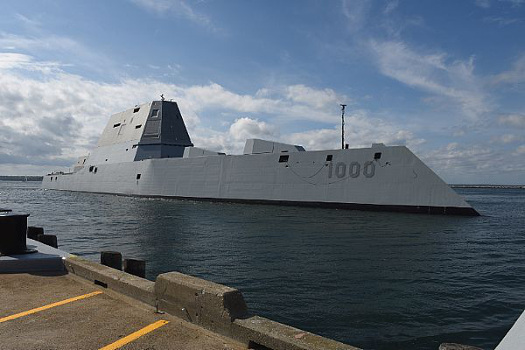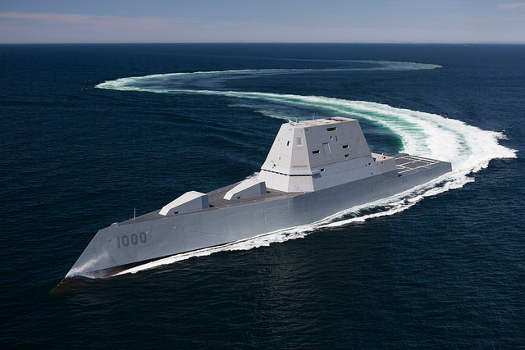 |
| October 25, 2016 | Volume 12 Issue 40 |
Designfax weekly eMagazine
Archives
Partners
Manufacturing Center
Product Spotlight
Modern Applications News
Metalworking Ideas For
Today's Job Shops
Tooling and Production
Strategies for large
metalworking plants
U.S. Navy commissions electric-propulsion stealth destroyer USS Zumwalt for service
By GE Reports

The new DDG 1000 USS Zumwalt destroyer features a 78-MW power station supplying electricity to an advanced integrated power system. [Image credit: U.S. Navy]
The U.S. Navy has commissioned for service the USS Zumwalt, its largest and most advanced stealth destroyer. The ceremony took place in Baltimore on October 15.
Named after the late Adm. Elmo "Bud" Zumwalt Jr., the 610-ft-long "multi-mission" ship was built at General Dynamics Bath Iron Works in Maine. The Navy estimates the 15,600-ton vessel can hit a target at a range of more than 60 miles. It also has a wave-piercing tumblehome design and a unique superstructure that make it less visible to enemy radar at sea.
The ship is equally innovative below deck. Traditionally, the Navy powered its vessels with gas turbines driving controllable pitch propellers through large and complex gearboxes. But the new destroyer has on board two Rolls-Royce MT30 Main Turbine Generator Sets (MTGs) and two RR4500 Auxiliary Turbine Generator Sets (ATGs) that power a 78-MW power station (nearly what a nuclear-powered aircraft carrier generates) supplying electricity to an advanced integrated power system (IPS). GE Marine designed the system, which powers giant GE induction motors connected directly to the propeller shafts and routes electricity to a vast array of sensors, weapons, radar, and other critical systems on board.
As a result, the ship will have nearly 10 times as much available power as its predecessors. In fact, the Zumwalt could become the first ship carrying next-generation weapons such as electromagnetic railguns, which use a strong electromagnetic pulse, rather than gunpowder, to shoot projectiles. "We're no longer restricting the engines to provide propulsion power only," Adam Kabulski, director for naval accounts at GE Power Conversion, told GE Reports. "This design allows you to send electric power wherever you need it. You can access many megawatts in a short amount of time and convert it into energy. It's instantaneous."
The system is also highly redundant. Instead of the typical three-phase motors, the Zumwalt's advanced induction motors have 15 phases. Kabulski said that by simply reversing the direction of the rotating magnetic field in the motor, for example, the shaft can turn in the opposite direction to give astern power. "The design is innovative, being smaller and quieter than traditional motors, and also highly survivable," he said.

DDG 1000 USS Zumwalt. [Image credit: U.S. Navy]
GE has been supplying electric propulsion technology to the shipping industry for a century. The Navy's first electrically propelled ship, the aircraft carrier USS Jupiter, was commissioned in 1913.
GE Marine technology is also operating on board the USS Makin Island, the Navy's first hybrid-propelled ship. Similar technology also runs inside the Royal Navy's Type 45 destroyer-class ships and numerous offshore, passenger, and cruise vessels, including the Queen Mary 2.
The destroyer spent the last year going through sea trials in the Atlantic Ocean. The Navy said the "ship [would] provide independent forward presence and deterrence, support special operation forces, and operate as an integral part of joint and combined expeditionary forces."
Extra stats from U.S. Navy about the ship
- BUILDER: General Dynamics Bath Iron Works
- ELECTRONICS: SPY-3 Radar and Combat System Integrator: Raytheon is the prime contractor responsible for the Design and Development of the ZUMWALT Mission System, including software, Mission System Equipment (MSE) and many of the sensors for the DDG 1000 Class.
- PROPULSION: (2) Main Turbine Generators (MTG); (2) Auxiliary Turbine Generators (ATG); (2) 34.6 MW Advanced Induction Motors (AIM)
- LENGTH: 610 ft
- BEAM: 80.7 ft
- DISPLACEMENT: 15,656 L tons
- SPEED: 30 knots
- CREW: 158 (including air det)
- ARMAMENT: (80) Advanced Vertical Launch (AVLS) cells for Tomahawk, ESSM, Standard Missile; (2) Advanced Gun System (AGS) 155 mm guns; Long-Range Land Attack Projectiles (LRLAP) 155 mm rounds; (2) MK 46 Close In Guns (CIGS); potential for rail gun*
- AIRCRAFT: (2)MH60R or (1) MH60R and (3) VTUAVs
* The U.S. Naval Institute reported that the Navy was considering the electromagnetic railgun for the third planned Zumwalt-class destroyer, USS Lyndon B. Johnson. The weapon can release up to 5 million amps, or 1,200 volts within 10 milliseconds, according to Military.com. That's enough to speed up a 45-lb projectile from zero to 5,000 mph in one one-hundredth of a second, the site said.
VIDEO: U.S. Navy rail gun tech. [Source: ArmedForcesUpdate]
Sources: GE Reports, U.S. Navy
Read more GE Reports at gereports.com.
Published October 2016
Rate this article
View our terms of use and privacy policy
